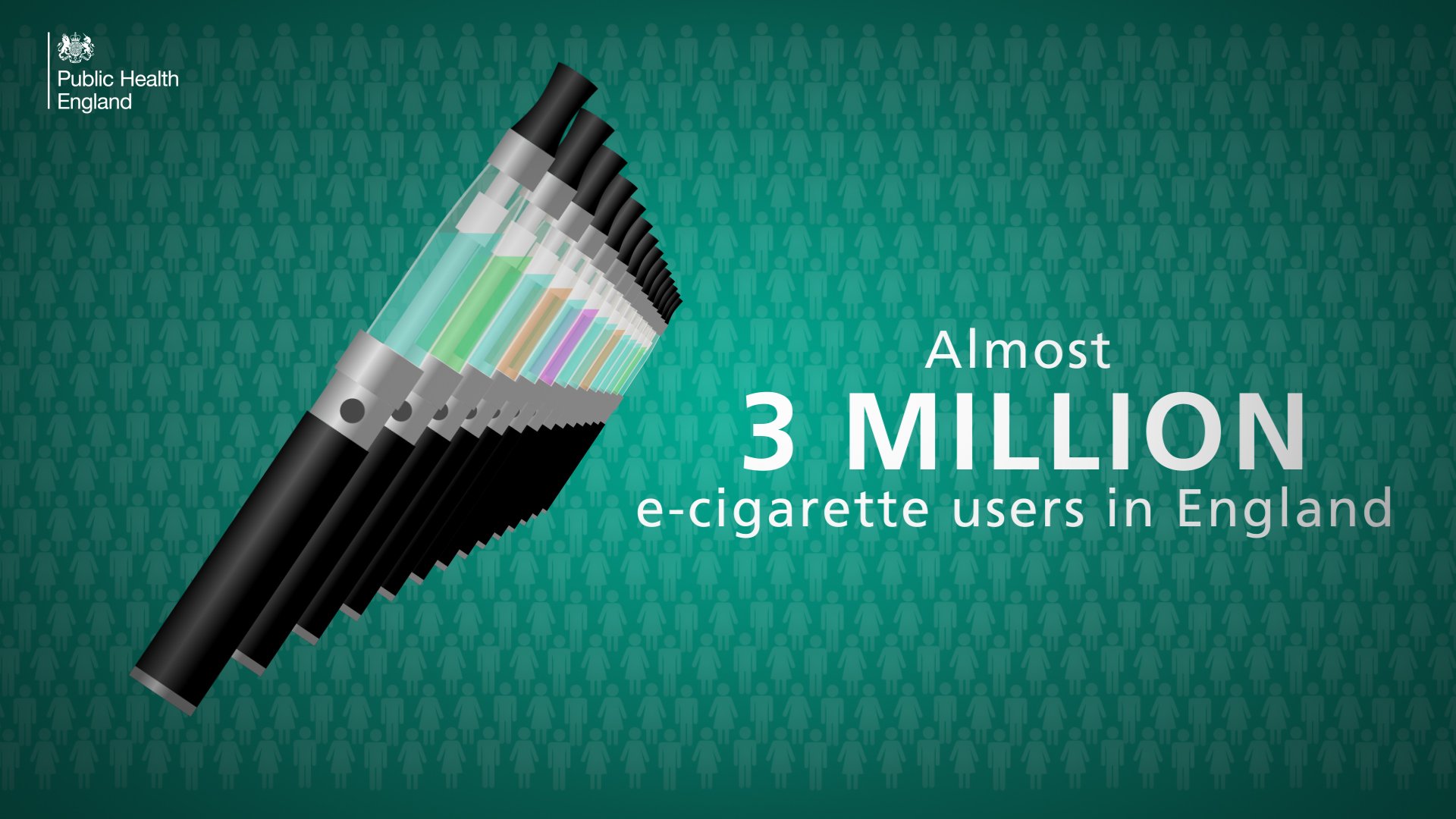Public Health England cracks down on vaping myths

Vaping is an industry that attracts scepticism. This is a fact, and any new technology that looks and sounds like smoking carries with it the baggage of the label, often having a severe negative effect on its public perception.
As a vaping company, we see the effect of word of mouth in the questions we are asked on a day to day basis. Diacetyl, popcorn lung and second hand smoke are regular topics of discussion in our stores. Public Health England has stepped forward to clear these concerns right up.
Popcorn Lung
The Myth:
Anyone who has heard of vaping, has most likely heard of the term 'popcorn lung'.
The disease, know in medicine as bronchiolitis obliterans, is a development of obstructive scar tissue on the lung which causes severe breathing problems throughout life, and is incurable.
The illness was linked with diacetyl, after popcorn factory workers exposed to unprocessed diacetyl were the first to suffer an major outbreak of the disease in late 2000.
In early tests of E-liquids and flavours, diacetyl was found to be present in a small selection of e-liquid, which lead to a public outcry against the industry.
The Reality:
However, what wasn't mentioned was the fact that thousands of products, including cigarettes, contain the chemical at far great concentrations than was ever found in e-cigarettes. 'Popcorn Lung' is an extremely rare disease, even with the large amounts of diacetyl the general public consumes day to day, so it is safe to assume it doesn't pose the risk that many believe.
Public Health England states that even smoking is not a major risk factor for the disease.
Even so, diacetyl is banned as an ingredient for e-cigarettes in the UK. Manufacturers refuse to use the substance, and work diligently to ensure that naturally occurring diacetyl is removed from the e-liquids they produce, with severe consequences if they fail to do so.
E-cigarettes aren’t regulated and we don’t know what’s in them
The Myth:
Vaping is a new and not very well understood industry. The process of manufacturing devices and E-liquids is unique to this industry specifically, a process that doesn't have a significant amount of historical basis.
This means that for much of vaping's history, regulation has been a complex issue, leaving many manufacturers to create and distribute products freely. The concern is that this creates the opportunity for abuse, with products that may breach health regulations.
The Reality:
The UK boasts some of the strictest regulations for e-cigarettes and vaping in the world. The Tobacco and Related Products Regulations 2016 introduced safety assurance, chemical checks, labelling requirements and public provision of manufacturing details to ensure that all producers were not only compliant, but able to ensure that a customer can make an informed choice regarding their products.
Any and all products must be reviewed by the UK Medicines and Healthcare products Regulatory Agency (MHRA) with full details on ingredients and manufacturing process.
Suffice to say, vaping is certainly regulated, and we absolutely know what e-liquids contain.
Nicotine causes cancer
The Myth:
According to Public Health England, 4 out of 10 smokers believe that nicotine causes the vast majority of cancer cases in smokers. As nicotine is often the most widely discussed chemical in smoking, it is understandable how this has come to pass. The thousands of carcinogenic chemicals contained in cigarettes are not understood by most of the public, and tend to get lost in favour for more infamous additions.
There is a wide variety of conflicting evidence surrounding nicotine, which makes understanding this chemical considerably harder. As most e-liquids contain nicotine, there has been a growing opinion that they must cause cancer.
The Reality:
Years of research has show that nicotine poses a minimal risk to health, but does indeed have addictive properties.
Nicotine is not considered a carcinogen in the UK, and it is instead the deadly cocktail of chemicals in cigarettes know as 'tar' that cause various types of cancer.
E-cigarettes do not contain or produce the two main harmful chemicals that tobacco includes; tar and carbon monoxide.
Whilst some chemicals in cigarettes can be found in vaping in vaping, they appear at a much lower levels. Public Health England has estimated that the reduction in toxins is as much as 95% lower than tobacco.
Vaping produces harmful second hand emissons
The Myth:
Second hand smoke from cigarettes is indeed harmful, and smoking in public places has been banned accordingly. However, vaping exists in a grey area, as the law does not cover them. This means that only private institutions such as businesses are able to make rules restricting vaping on their property .
Vaping looks, sounds and can smell like smoking, producing a thick vapour which can be inhaled by those nearby to a vaper. It is believed that this could be a risk to the health of the general public, similar to the damage that can occur from second hand smoke.
The Reality:
E-liquid is made of a few key ingredients, such as propylene glycol (PG), vegetable/synthetic glycerine and flavourings. In studies of second hand inhalation of vaping products, it was found that unlike cigarettes, there is no identified risks from passive vaping.
This evidence comes from Public Health England, who has show that to date, the is no evidence to suggest risk. People with lung conditions such asthma can suffer mild irritation, but for the average healthy member of the public there is very little risk.
E-cigarettes are being used as a Trojan horse – so the tobacco industry can keep people smoking
Myth:
Conspiracy theories are common, but there is a growing theory developing around vaping.
In the last few years there has been a growing sentiment surrounding the idea that e-cigarettes may be a tool to get non-smokers to take up traditional smoking habits.
By attracting people to E-cigarettes, it can be a gateway to trying and becoming addicted to tobacco. Furthermore, there exists the theory that tobacco companies want to introduce e-cigarettes as a healthy alternative, followed by sponsored media backlash to cause many vapers to abandon their devices in favour of smoking.
The Reality:
In short, no.
There is no current evidence that suggests more people are returning to or starting smoking. Within the UK, smoking rates have fallen to the 2nd lowest in Europe (15.5%), with over 2.9 million vapers having ceased using cigarettes entirely.
This doesn't include over 770,000 users who have quit both.
Furthermore, whilst there has been an enormous amount of misinformative media focusing on vaping, studies have quickly invalidated the claims.
And finally, vaping companies are not controlled by tobacco firms. While some have been assimilated into larger tobacco companies, the vast majority are independents created by ex-smokers. Nothing would be beneficial about sabotaging our own industry, so you can rest assured that bringing back smoking will never be on our agenda.
We'll let Public Health England themselves finish this piece off, as the credit rests on their shoulders:
'Our evidence review indicates that e-cigarettes could be contributing to at least 20,000 successful new quits per year and possibly many more.
In summary, e-cigarettes and tobacco cigarettes are not the same and shouldn’t be treated as such. It’s important that England’s seven million smokers are aware of the differences and have accurate information to inform their health decisions. E-cigarettes aren’t completely risk free but carry a fraction of the risk of smoking and are helping thousands of smokers to quit and stay smokefree.'
And there you have it. Vaping is here to help.












